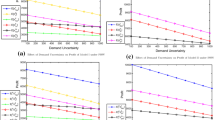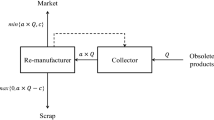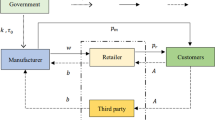Abstract
In reverse supply chain (RSC) systems, disruptions in the collection process of used items may negatively influence the efficiency of RSC participators. Inspired by a real case study, this paper contributes to the RSC systems coordination literature by analyzing the effect of collection disruptions on the efficiency of an RSC system with dual collection channels using a coordination contract approach. Moreover, this study explores the effect of collection competition between two collection channels (collector channel and remanufacturer channel) on the acquisition prices offered to consumers as incentive schemes for returning the used items. This study determines the equilibrium solutions for selling prices of remanufactured products, acquisition prices, and transfer price under decentralization, centralization, and coordination settings. Additionally, this study incorporates the impact of collection disruptions into the remanufacturer’s and collector’s problem considering four scenarios. Furthermore, this study proposes a disruption-based two-part tariff contract to accomplish channel coordination in the RSC system with dual-collection channel under collection disruptions. Our finding reveals that the suggested coordinated scheme efficiently coordinates the disrupted RSC with dual collection channels even when under high possibility of collection disruptions. Moreover, our coordination plan is of environmental and economic benefits, as it can boost the return quantities and can increase RSC participators’ profits.










Similar content being viewed by others
References
Arshinder, K., Kanda, A., & Deshmukh, S. G. (2011). A review on supply chain coordination: Coordination mechanisms, managing uncertainty and research directions. In T. M. Choi & T. Cheng (Eds.), Supply chain coordination under uncertainty (pp. 39–82). Springer.
Aslani, A., & Heydari, J. (2019). Transshipment contract for coordination of a green dual-channel supply chain under channel disruption. Journal of Cleaner Production, 223, 596–609.
Batarfi, R., Jaber, M. Y., & Glock, C. H. (2019). Pricing and inventory decisions in a dual-channel supply chain with learning and forgetting. Computers & Industrial Engineering, 136, 397–420.
Cachon, G. P. (2003). Supply chain coordination with contracts. Handbooks in Operations Research and Management Science, 11, 227–339.
Cachon, G. P., & Kök, A. G. (2010). Competing manufacturers in a retail supply chain: On contractual form and coordination. Management Science, 56(3), 571–589.
Cai, G. G., Zhang, Z. G., & Zhang, M. (2009). Game theoretical perspectives on dual-channel supply chain competition with price discounts and pricing schemes. International Journal of Production Economics, 117(1), 80–96.
Cao, E. (2014). Coordination of dual-channel supply chains under demand disruptions management decisions. International Journal of Production Research, 52(23), 7114–7131.
Cao, E., Wan, C., & Lai, M. (2013). Coordination of a supply chain with one manufacturer and multiple competing retailers under simultaneous demand and cost disruptions. International Journal of Production Economics, 141(1), 425–433.
Cao, K., He, P., & Liu, Z. (2020). Production and pricing decisions in a dual-channel supply chain under remanufacturing subsidy policy and carbon tax policy. Journal of the Operational Research Society, 71(8), 1199–1215.
Chen, K. C., Huang, S. H., & Lian, I. W. (2010). The development and prospects of the end-of-life vehicle recycling system in Taiwan. Waste Management, 30(8–9), 1661–1669.
Choi, T. M. (2017). Pricing and branding for remanufactured fashion products. Journal of Cleaner Production, 165, 1385–1394.
Choi, T. M., & Cheng, T. E. (2015). Sustainable fashion supply chain management. Springer.
Choi, T. M., Li, Y., & Xu, L. (2013). Channel leadership, performance and coordination in closed loop supply chains. International Journal of Production Economics, 146(1), 371–380.
Dan, B., Xu, G., & Liu, C. (2012). Pricing policies in a dual-channel supply chain with retail services. International Journal of Production Economics, 139(1), 312–320.
De Giovanni, P. (2014). Environmental collaboration in a closed-loop supply chain with a reverse revenue sharing contract. Annals of Operations Research, 220(1), 135–157.
De Giovanni, P. (2017). Closed-loop supply chain coordination through incentives with asymmetric information. Annals of Operations Research, 253(1), 133–167.
Diabat, A., Jabbarzadeh, A., & Khosrojerdi, A. (2019). A perishable product supply chain network design problem with reliability and disruption considerations. International Journal of Production Economics, 212, 125–138.
Feng, L., Govindan, K., & Li, C. (2017). Strategic planning: Design and coordination for dual-recycling channel reverse supply chain considering consumer behavior. European Journal of Operational Research, 260(2), 601–612.
Fleischmann, M., Van Nunen, J. A., & Gräve, B. (2003). Integrating closed-loop supply chains and spare-parts management at IBM. Interfaces, 33(6), 44–56.
Fuli, G., Foropon, C., & Xin, M. (2020). Reducing carbon emissions in humanitarian supply chain: The role of decision making and coordination. Annals of Operations Research. https://doi.org/10.1007/s10479-020-03671-z
Galbreth, M. R., Boyacı, T., & Verter, V. (2013). Product reuse in innovative industries. Production and Operations Management, 22(4), 1011–1033.
Giri, B. C., & Sarker, B. R. (2017). Improving performance by coordinating a supply chain with third party logistics outsourcing under production disruption. Computers & Industrial Engineering, 103, 168–177.
Giutini, R., & Gaudette, K. (2003). Remanufacturing: The next great opportunity for boosting US productivity. Business Horizons, 46(6), 41–48.
Govindan, K., Popiuc, M. N., & Diabat, A. (2013). Overview of coordination contracts within forward and reverse supply chains. Journal of Cleaner Production, 47, 319–334.
Guo, S., Shen, B., Choi, T. M., & Jung, S. (2017). A review on supply chain contracts in reverse logistics: Supply chain structures and channel leaderships. Journal of Cleaner Production, 144, 387–402.
Han, X., Shen, Y., & Bian, Y. (2020). Optimal recovery strategy of manufacturers: Remanufacturing products or recycling materials? Annals of Operations Research, 290(1), 463–489.
Hasanov, P., Jaber, M. Y., & Tahirov, N. (2019). Four-level closed loop supply chain with remanufacturing. Applied Mathematical Modelling, 66, 141–155.
Heydari, J., Govindan, K., & Jafari, A. (2017). Reverse and closed loop supply chain coordination by considering government role. Transportation Research Part D: Transport and Environment, 52, 379–398.
Hosseini-Motlagh, S. M., Ebrahimi, S., & Jokar, A. (2019a). Sustainable supply chain coordination under competition and green effort scheme. Journal of the Operational Research Society. https://doi.org/10.1080/01605682.2019.1671152
Hosseini-Motlagh, S. M., Jazinaninejad, M., & Nami, N. (2020a). Recall management in pharmaceutical industry through supply chain coordination. Annals of Operations Research. https://doi.org/10.1007/s10479-020-03720-7
Hosseini-Motlagh, S. M., Johari, M., Ebrahimi, S., & Rogetzer, P. (2020b). Competitive channels coordination in a closed-loop supply chain based on energy-saving effort and cost-tariff contract. Computers & Industrial Engineering, 149, 106763. https://doi.org/10.1016/j.cie.2020.106763
Hosseini-Motlagh, S. M., Nematollahi, M., Johari, M., & Choi, T. M. (2019b). Reverse supply chain systems coordination across multiple links with duopolistic third party collectors. IEEE Transactions on Systems, Man, and Cybernetics: Systems,. https://doi.org/10.1109/TSMC.2019.2911644
Hosseini-Motlagh, S. M., Nouri-Harzvili, M., Choi, T. M., & Ebrahimi, S. (2019c). Reverse supply chain systems optimization with dual channel and demand disruptions: Sustainability, CSR investment and pricing coordination. Information Sciences, 503, 606–634.
Jabbarzadeh, A., Haughton, M., & Khosrojerdi, A. (2018). Closed-loop supply chain network design under disruption risks: A robust approach with real world application. Computers & Industrial Engineering, 116, 178–191.
Jamali, M. B., & Rasti-Barzoki, M. (2018). A game theoretic approach for green and non-green product pricing in chain-to-chain competitive sustainable and regular dual-channel supply chains. Journal of Cleaner Production, 170, 1029–1043.
Javadi, T., Alizadeh-Basban, N., Asian, S., & Hafezalkotob, A. (2019). Pricing policies in a dual-channel supply chain considering flexible return and energy-saving regulations. Computers & Industrial Engineering, 135, 655–674.
Johari, M., & Hosseini-Motlagh, S. M. (2019). Coordination of social welfare, collecting, recycling and pricing decisions in a competitive sustainable closed-loop supply chain: A case for lead-acid battery. Annals of Operations Research. https://doi.org/10.1007/s10479-019-03292-1
Jokar, A., & Hosseini-Motlagh, S. M. (2020). Simultaneous coordination of order quantity and corporate social responsibility in a two-Echelon supply chain: A combined contract approach. Journal of the Operational Research Society, 71(1), 69–84.
Karakayali, I., Emir-Farinas, H., & Akcali, E. (2007). An analysis of decentralized collection and processing of end-of-life products. Journal of Operations Management, 25(6), 1161–1183.
Li, J., Wang, Z., Jiang, B., & Kim, T. (2017). Coordination strategies in a three-echelon reverse supply chain for economic and social benefit. Applied Mathematical Modelling, 49, 599–611.
Liao, H., & Li, L. (2021). Environmental sustainability EOQ model for closed-loop supply chain under market uncertainty: A case study of printer remanufacturing. Computers & Industrial Engineering, 151, 106525.
Liu, B., & De Giovanni, P. (2019). Green process innovation through Industry 4.0 technologies and supply chain coordination. Annals of Operations Research. https://doi.org/10.1007/s10479-019-03498-3
Liu, P., & Yi, S. P. (2018). A study on supply chain investment decision-making and coordination in the Big Data environment. Annals of Operations Research, 270(1), 235–253.
Liu, X., Li, J., Wu, J., & Zhang, G. (2017). Coordination of supply chain with a dominant retailer under government price regulation by revenue sharing contracts. Annals of Operations Research, 257(1), 587–612.
Ma, J., Ai, X., Yang, W., & Pan, Y. (2019). Decentralization versus coordination in competing supply chains under retailers’ extended warranties. Annals of Operations Research, 275(2), 485–510.
Majumder, P., & Srinivasan, A. (2006). Leader location, cooperation, and coordination in serial supply chains. Production and Operations Management, 15(1), 22–39.
Modak, N. M., & Kelle, P. (2019). Managing a dual-channel supply chain under price and delivery-time dependent stochastic demand. European Journal of Operational Research, 272(1), 147–161.
Nematollahi, M., Hosseini-Motlagh, S. M., & Heydari, J. (2017). Coordination of social responsibility and order quantity in a two-echelon supply chain: A collaborative decision-making perspective. International Journal of Production Economics, 184, 107–121.
Nematollahi, M., Hosseini-Motlagh, S. M., Ignatius, J., Goh, M., & Nia, M. S. (2018). Coordinating a socially responsible pharmaceutical supply chain under periodic review replenishment policies. Journal of Cleaner Production, 172, 2876–2891.
Östlin, J., Sundin, E., & Björkman, M. (2008). Importance of closed-loop supply chain relationships for product remanufacturing. International Journal of Production Economics, 115(2), 336–348.
Qi, X., Bard, J. F., & Yu, G. (2004). Supply chain coordination with demand disruptions. Omega, 32(4), 301–312.
Reimann, M., Xiong, Y., & Zhou, Y. (2019). Managing a closed-loop supply chain with process innovation for remanufacturing. European Journal of Operational Research, 276(2), 510–518.
Savaskan, R. C., Bhattacharya, S., & Van Wassenhove, L. N. (2004). Closed-loop supply chain models with product remanufacturing. Management Science, 50(2), 239–252.
Savaskan, R. C., & Van Wassenhove, L. N. (2006). Reverse channel design: The case of competing retailers. Management Science, 52(1), 1–14.
Shen, B., Choi, T. M., & Minner, S. (2019). A review on supply chain contracting with information considerations: Information updating and information asymmetry. International Journal of Production Research, 57(15–16), 4898–4936.
Taleizadeh, A. A., Alizadeh-Basban, N., & Niaki, S. T. A. (2019). A closed-loop supply chain considering carbon reduction, quality improvement effort, and return policy under two remanufacturing scenarios. Journal of Cleaner Production, 232, 1230–1250.
Tang, S., Wang, W., & Zhou, G. (2020). Remanufacturing in a competitive market: A closed-loop supply chain in a Stackelberg game framework. Expert Systems with Applications, 161, 113655. https://doi.org/10.1016/j.eswa.2020.113655
Valenzuela, K. B. (2009). A study of closed-loop supply chain models with governmental incentives and fees. Iowa State University.
Wagner, S. M., & Bode, C. (2006). An empirical investigation into supply chain vulnerability. Journal of Purchasing and Supply Management, 12(6), 301–312.
Wan, N., & Hong, D. (2019). The impacts of subsidy policies and transfer pricing policies on the closed-loop supply chain with dual collection channels. Journal of Cleaner Production, 224, 881–891.
Wang, K., Zhao, Y., Cheng, Y., & Choi, T. M. (2014b). Cooperation or competition? Channel choice for a remanufacturing fashion supply chain with government subsidy. Sustainability, 6(10), 7292–7310.
Wang, L., & Chen, M. (2013). Policies and perspective on end-of-life vehicles in China. Journal of Cleaner Production, 44, 168–176.
Wang, Y., Chang, X., Chen, Z., Zhong, Y., & Fan, T. (2014a). Impact of subsidy policies on recycling and remanufacturing using system dynamics methodology: A case of auto parts in China. Journal of Cleaner Production, 74, 161–171.
Wang, Z., Huo, J., & Duan, Y. (2019). Impact of government subsidies on pricing strategies in reverse supply chains of waste electrical and electronic equipment. Waste Management, 95, 440–449.
Wei, J., Wang, Y., Zhao, J., & Gonzalez, E. D. S. (2019). Analyzing the performance of a two-period remanufacturing supply chain with dual collecting channels. Computers & Industrial Engineering, 135, 1188–1202.
Wu, C., Li, K., & Shi, T. (2017). Supply chain coordination with two-part tariffs under information asymmetry. International Journal of Production Research, 55(9), 2575–2589.
Xiao, T., & Qi, X. (2008). Price competition, cost and demand disruptions and coordination of a supply chain with one manufacturer and two competing retailers. Omega, 36(5), 741–753.
Xu, L., & Wang, C. (2018). Sustainable manufacturing in a closed-loop supply chain considering emission reduction and remanufacturing. Resources, Conservation and Recycling, 131, 297–304.
Yang, L., Hu, Y., & Huang, L. (2020). Collecting mode selection in a remanufacturing supply chain under cap-and-trade regulation. European Journal of Operational Research, 287(2), 480–496.
Yang, M., & Gong, X. M. (2021). Optimal decisions and Pareto improvement for green supply chain considering reciprocity and cost-sharing contract. Environmental Science and Pollution Research, 28(23), 29859–29874.
Yang, M., Zhang, T., & Wang, C. X. (2021). The optimal e-commerce sales mode selection and information sharing strategy under demand uncertainty. Computers & Industrial Engineering, 162, 107718. https://doi.org/10.1016/j.cie.2021.107718
Yang, M., Zhang, T., & Zhang, Y. (2022). Optimal pricing and green decisions in a dual-channel supply chain with cap-and-trade regulation. Environmental Science and Pollution Research, 29, 28208–28225.
Yin, J., Gao, Y., & Xu, H. (2014). Survey and analysis of consumers’ behaviour of waste mobile phone recycling in China. Journal of Cleaner Production, 65, 517–525.
Zhang, P., Xiong, Y., & Xiong, Z. (2015). Coordination of a dual-channel supply chain after demand or production cost disruptions. International Journal of Production Research, 53(10), 3141–3160.
Zhang, T., Choi, T. M., & Zhu, X. (2018). Optimal green product’s pricing and level of sustainability in supply chains: Effects of information and coordination. Annals of Operations Research. https://doi.org/10.1007/s10479-018-3084-8
Zhang, W. G., Fu, J., Li, H., & Xu, W. (2012). Coordination of supply chain with a revenue-sharing contract under demand disruptions when retailers compete. International Journal of Production Economics, 138(1), 68–75.
Zhang, Y., Chen, W., & Mi, Y. (2020). Third-party remanufacturing mode selection for competitive closed-loop supply chain based on evolutionary game theory. Journal of Cleaner Production, 263, 121305. https://doi.org/10.1016/j.jclepro.2020.121305
Zhao, J., Wei, J., & Li, M. (2017). Collecting channel choice and optimal decisions on pricing and collecting in a remanufacturing supply chain. Journal of Cleaner Production, 167, 530–544.
Zhao, S., & Zhu, Q. (2017). Remanufacturing supply chain coordination under the stochastic remanufacturability rate and the random demand. Annals of Operations Research, 257(1), 661–695.
Zheng, B., Yang, C., Yang, J., & Zhang, M. (2017). Pricing, collecting and contract design in a reverse supply chain with incomplete information. Computers & Industrial Engineering, 111, 109–122.
Author information
Authors and Affiliations
Corresponding author
Additional information
Publisher's Note
Springer Nature remains neutral with regard to jurisdictional claims in published maps and institutional affiliations.
Appendices
Appendix A. Proofs of propositions
Proof of Proposition 1 of Proposition 1
By taking the second-order derivative of \(E\left({\varPi }_{c}\left({a}_{c}\right)\right)\) w.r.t. \({a}_{c}\) under the Remanufacturer–Stackelberg game, we have \(\frac{{\partial }^{2}E\left({\varPi }_{c}\left({a}_{c}\right)\right)}{\partial {{a}_{c}}^{2}}=-2\beta \left(1-{r}_{c}\right)<0\). Thus, the TWEP of the collector is concave w.r.t.\( {a}_{c}\).\(\square\)
Proof of Proposition 2
The second-order derivative of \(E\left({\varPi }_{rm}\left(T,{a}_{m}\right)\right)\) w.r.t. \(T\) is \(\frac{{\partial }^{2}E\left({\varPi }_{m}\left(T,{ a}_{m}\right)\right)}{\partial {T}^{2}} =-\left(\frac{{\tau }^{2}{\left(\beta -\gamma \right)}^{2}}{\mu {\left(1-{r}_{c}\right)}^{2}}+\frac{\beta }{1-{r}_{c}}\right)<0\). Therefore, the remanufacturer’ TWEP is concave w.r.t. \(T\) for a given \({a}_{m}\) under the Remanufacturer–Stackelberg game.\(\square\)
Proof of Proposition 3
Taking the second-order derivative of \(E\left({\varPi }_{SC}\left({a}_{m},{a}_{c}\right)\right)\) w.r.t. \({a}_{c}\), we have \(\frac{{\partial }^{2}E\left({\varPi }_{SC}\left({a}_{m}, {a}_{c}\right)\right)}{\partial {{a}_{c}}^{2}} =-\left(2\beta \left(1-{r}_{c}\right)+\frac{2{\tau }^{2}}{\mu }{\left(\beta -\gamma \right)}^{2}\right)<0\). Thus, the TWEP of the whole RSC under the centralized structure is concave w.r.t. \({a}_{c}\) for a given \({a}_{m}\).\(\square\)
Proof of Proposition 4
The remanufacturer and the collector agree on the proposed reverse disruption-based two-part tariff contract if and only if their TWEPs are at least equal to those of the decentralized model. Therefore, we have:
in which, \(dec\) indicates Remanufacture–Stackelberg game structure, i.e., RMS. Eqs. (A1) and (A2), ensure the expectations of the collector and the remanufacturer for participating in the coordination model, are met, respectively. It is noteworthy that the lower and upper bounds of fixed fee, i.e., \({F}_{min}\) and \({F}^{max}\) are calculated by simplifying Eqs. (A1) and (A2), respectively.\(\square\)
Appendix B. Supplementary symbols
Considering Eqs. (4) and (5), the TWEP of the remanufacturer can be formulated as follows:
From constraint (B13-1), \({p}_{m}\) can be determined as \({p}_{m}=\frac{\lambda }{\mu }-\frac{\tau }{\mu }\left(\chi +\left(\beta -\gamma \right)\left({a}_{c}+{a}_{m}\right)\right)\). Then, by substituting \(p_{m}\) into Eq. (B13), Eq. (6) will be determined. Equation (11) can be equivalently written as follows:
Based upon constraint (B15), \({p}_{m}\) can be determined as \({p}_{m}=\frac{\lambda }{\mu }-\frac{\tau }{\mu }\left(\chi +\left(\beta -\gamma \right)\left({a}_{c}+{a}_{m}\right)\right)\), and then by substituting \({p}_{m}\) into \(E\left({\varPi }_{SC}\left({p}_{m},{a}_{m},{a}_{c}\right)\right)\), the TWEP of the whole RSC is converted to:
Rights and permissions
Springer Nature or its licensor holds exclusive rights to this article under a publishing agreement with the author(s) or other rightsholder(s); author self-archiving of the accepted manuscript version of this article is solely governed by the terms of such publishing agreement and applicable law.
About this article
Cite this article
Hosseini-Motlagh, SM., Johari, M., Nematollahi, M. et al. Reverse supply chain management with dual channel and collection disruptions: supply chain coordination and game theory approaches. Ann Oper Res 324, 215–248 (2023). https://doi.org/10.1007/s10479-022-04909-8
Accepted:
Published:
Issue Date:
DOI: https://doi.org/10.1007/s10479-022-04909-8




